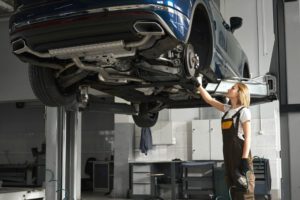Quick Navigation
What Is a Car’s Undercarriage?
Undercarriage is the part of the car that makes direct contact with the road. In other words, it includes the exhaust system, suspension, and gas tank.
The importance of the undercarriage is to keep the car in good balance and to protect it from any external damage, for example, from pebbles or stones.
For those who drive a car professionally, such as a taxi driver or courier, the condition of their vehicle’s undercarriage is particularly important because that is how they earn their living.

This means they need to regularly check that the undercarriage is undamaged and clean.
Safety is the main concern when it comes to the undercarriage of your vehicle.
The suspension system is a major factor in keeping your car safe, particularly if you are driving over rough roads or on bad paved roads.
The suspension system also helps you to control your car while you are driving. It makes your car feel more stable and easier to drive at high speeds.
What Does Undercarriage Damage Mean?
Undercarriage damage is any damage to the body of a car, from minor dents and scratches to serious damage that involves the vehicle’s bodywork being completely destroyed.
If your car’s undercarriage falls into this category, you need to take it to a mechanic as soon as possible.
Undercarriage Damage Is Divided Into Several Categories:
What Causes Undercarriage Damage?
Damage can occur for many reasons but here are some of the most common:
- Mud: Mud on the undercarriage is caused by rainwater. When this soaks into the rubber or plastic of the car and then dries, it will cause cracks. This will lead to the undercarriage surface being deformed and is dangerous for tires.
- Potholes: Potholes are found on roads and cause the undercarriage of a car to be damaged. This is because the rubber and plastic parts of the undercarriage take a long time to dry after being wet from rainwater so it is common for them to be cracked.
- Road roughness: Road roughness causes the wheels of a car to scrape against the road and can damage their undercarriages.
- Salt: Salt used for road salting can lead to corrosion on the undercarriage.
How to Identify Undercarriage Damage?
The following are the most common signs of undercarriage damage:
- Cracks in the rubber or plastic undercarriage surface
- Dented or dinged metal parts and parts that are heavily bent inwards
- Green or blue residue on the undercarriage
- Excess rust on metal parts. This is caused by corrosion and can lead to small scratches on metal areas.
- Chipped and scratched paintwork, especially when there is also a green or blue residue.
- Leaking fluid: Leaking fluid is caused by damaged pipes and seals.
- Suspension damage: Damage to the suspension indicates that it has taken a heavy shock. This can cause the suspension to be bent or warped, or even rub against its own undercarriage.
Proper Maintenance of a Vehicle’s Undercarriage
Undercarriage damage can be prevented by avoiding the situations above and through regular inspections of your vehicle’s undercarriage.
Nevertheless, there is no way to eliminate all the risks associated with driving, so thorough inspections must be carried out for the safety of yourself, your passengers and other drivers on the road.
Unfortunately, there is no way to avoid all undercarriage damage. Some vehicles are more reliable and some cars will have a longer working life than others.

However, there are still some ways that you can tackle the problem of undercarriage damage when it occurs.
- Inspections: It is important to do a thorough inspection every time you take your car out for a drive. This includes checking tire pressure, light bulbs, brake pads, steering and suspension components as well as other parts. Look for any defects that might indicate that the undercarriage is damaged.
- Take it to a mechanic: Do not try to fix the problem yourself. Mechanics have the necessary tools, knowledge and experience to correctly identify and repair undercarriage damage.
- Regular maintenance service: A regular service includes additional checks that are not included in a simple inspection, such as close examination of the undercarriage. However, only a mechanic can do this because they will be equipped with specialized tools and equipment.
Maintaining the undercarriage of a car is important. A well-maintained undercarriage will protect your car, prolong its life, and save you a lot of money down the road.
Having a well-maintained undercarriage requires that these parts are regularly inspected for cracks, corrosion and other damage as well as leakages.
Is It Important to Wash Your Car’s Undercarriage?
Yes, it is very important to wash your car’s undercarriage. The undercarriage of your car is the area which makes direct contact with the road and this is where dirt, grime and dust accumulates.
These all cause the undercarriage to look dirty, filthy and greasy, which in turn causes rusting and deterioration of components of the undercarriage.
Cleaning the undercarriage is one of the most effective ways to avoid rust formation, as well as preventing your car from staining and ultimately, getting damaged.
Since rusting and stains are difficult to remove, it is best to prevent them by cleaning your car’s undercarriage regularly.
Safety Improvements for Your Cars Undercarriage
Car designers are constantly improving the safety features of modern cars and you can find a lot of these improvements on the car’s undercarriage.
Whether your car is new or old, you should still check for damage regularly and look at the condition of your car’s undercarriage.
Undercarriage Damage: How to Keep It From Happening to You
Thankfully, cars nowadays have a lot of safety features that can help keep the car and its driver safe. One of those is the undercarriage.
When you think of ‘undercarriage’, you may think about a car’s dirty parts or what is underneath it.
However, the undercarriage is actually the bottom part of a car which protects it from damage, especially when the car gets stuck on rough roads or crashes.
Ways to Prevent Undercarriage Damage
There are many ways that you can prevent your car from getting damaged, but it will take a lot of effort and the utmost care of undercarriage maintenance in order to do so.
Without proper maintenance, your undercarriage is likely to get damaged at some point in time.
The following are some tips for helping prevent undercarriage damage:
- Do not park over long periods of time or leave your car parked with the engine running.
- Do not drive on rough and uneven roads.
- Make sure to check the pressure of your tires regularly.
- Make sure to check for rusting and other imperfections on your undercarriage regularly.
- Make sure to change your oil regularly and check coolant levels.
- Keep the interior of your car clean to ensure that there are no spills that could get into the undercarriage and damage it.
Cars are made to last a long time and with proper maintenance, you can extend your car’s life by years.
This means that you need to inspect, service and repair your vehicle regularly or it will break down much sooner than expected.
One way of doing this is to have the undercarriage of your car regularly inspected by local mechanics who know what they are doing.
You would also need to inspect the undercarriage of your car periodically and check for any damage, leaks and other irregularities.

With comprehensive experience in writing exceptional quality articles and blogs about cars and related stuff, Daniel is one of the finest bloggers and a hardcore car lover we have. He is an ASE certified technician with an across-the-board experience of 10 years in the industry. He could not help tinkering with anything he got his hands on from a young age, which led to his remarkable career in the automotive repair industry.
When he is not under any hood, you can find him on the water or in the woods to pursue his passion for hunting and fishing. He has been writing for multiple sectors and is a regular contributor to several publications.
He currently owns a Nissan 300ZX TT and a Pearl Yellow but plans to upgrade it to 550 HP. His favorites include the Koenigsegg CCX and Lamborghini Diablo 6.0 VT, but for him, the Ferrari 360 Spider is one of the sexiest cars that exists to date.
Being an avid world traveler, he has spent most of his time analyzing the automotive markets, latest technology, and local favorites to enhance his knowledge base. He is currently living in North Caroline, where it’s all about food and coffee and, of course, cars.







